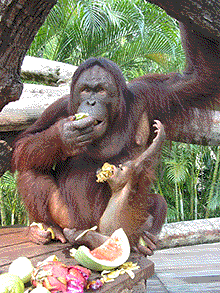Buying airline tickets for a low price is a kind of art, and often confuses people a lot. If you ask around during a flight you will probably not find two passengers who paid the same fare for the same type of seat. In fact, some passengers might have paid ten times as much as others, for the same few centimeters of leg-space. To get the lowest fares, you will have to know how the business works.
Airlines sell seats, and want to sell them at the highest price possible. They don't like to fly empty seats, as they cost them money. They publish official (IATA) airfares, often more than a year ahead, but these are so high that only very few people actually pay them: often business travelers who are fully reimbursed by their companies, and thus lack any incentive to search for cheaper alternatives, and people with an urgent need to travel at the last moment.
At the IATA fares, very few airplanes would fill-up, so airlines also offer discounted fares. Airlines actually employ specialist, who try to calculate, given market conditions, when to offer seats for a certain price. As a result, you may be able to buy an expensive ticket on a certain flight, but get "not available" if you try to book the same flight with a lower fare. People waiting for such a low fare will quickly consume those seats after they become availble, after which again only higher fares can be booked. A few weeks later, depending on bookings, cheaper seats may be offered again. Trying to get a low fare is very much like buying cheap on the stock exchange.
Where to get cheap air tickets?Air Arabia.com From Sharjah (UAE) to the Middle East, North Africa, India and Sri Lanka Aero Asia International Karachi (Pakistan) & Dubai Air Asia Internal and regional flights from hubs in Kuala Lumpur, Johor Bahru, Bangkok and Jakarta Air Blue.com Routes within Pakistan and between Pakistan and Dubai Air Deccan Bangalore (India) Air-India Express From Indian cities to international destinations Air Philippines Awair Jakarta (Indonesia)Bangkok Airlines From Bangkok; destinations in Thailand, Cambodia, China and Myanmar (Burma) Cebu Pacific Air Manila (Philippines) GA-Citilink.com All over Indonesia Gulf Traveller.com From the Middle East to India, Pakistan, Nepal and East Africa Hong Kong Express Jetstar Asia Airways From Singapore to Asian destinations Lion Air Main hub in Jakarta, Indonesia; domestic destinations NokAir From Bangkok, Thailand to Thai destinations One-Two-GO From Bangkok, Thailand to domestic destinations Pacific Airlines Vietnam; Mostly internal but a few international Phuket Air Internal flights (Thailand) Siem Reap International Flights between Siem Reap (for Angkor Wat), Phnom Penh and Bangkok SpiceJet.com Comprehensive network around IndiaThai AirAsia Internal and regional flights Tiger Airways Low cost flights from Singapore Changi Airport to Southeast Asia Valuair To Southeast Asia, China and Australia from Singapore Ultimate Tips1. Be flexible.
If you can leave a few days earlier or later, you can often save considerably, as cheaper tickets may still be available on a less popular day than your preferred day. Avoid the days most business people like to travel. Tuesdays and Wednesdays can be much cheaper days to fly on than Fridays, the Weekend, and Mondays. This is true both on-line and when dealing with a traditional agent. Staying out of the high seasons can also save you considerably, so ask agents when high (and so called shoulder) seasons start and end, and start working backwards from those dates, if need to book near the high season (Your departure date normally determines your fare).
Alternatively, you can have considerable price differences between various airports, so if you can choose between two airports for destination or departure, you can make considerable savings as well. When flying to the Philippines, going directly to Cebu is normally somewhat more expensive than flying to Manila.
Finally, people don't like stop-overs, so flights having some stop-overs might actually be cheaper than more convenient direct flights.
The lowest fares can be had if you're willing to take the risk of not flying at all, or a few days later, and can be stand-by for any seat available on 24 hour notice -- but be aware that although this too is sometimes called "last minute" you sometimes have to register for that option a few months beforehand.
Booking with an agent or web-site aimed at your own region or country is normally cheaper than trying to book a flight on a web-site operating at the other end of the globe. Specialized agents for your destination may be able to get better deals than non-specialized agents.
2. Plan Ahead.Since business travellers often have to change their itenary in the last moment, and like to be at home for the weekends, "last minute" tickets, and those not including at least one Saturday are much more expensive than those booked long beforehand or including Saturdays. In a few cases, even a "one way" flight can cost more than a full round trip! You normally can plan a holiday trip much longer beforehand, and thus get cheaper tickets, so don't wait too long.
3. Know your price.
Don't buy too early. If you monitor the prices of tickets on your route for some time, you will quickly learn what is the bottom price for that route. Those are often those fares published but never seem to be available when you try to book them. This activity is also known as bench-marking.
My personal bottom rate on the Amsterdam-Manila route is about 550 euros, and on Amsterdam-Cebu, 650. For stand-by tickets Amsterdam-Manila, you may be able to get them as low as 400 euros. I don't have an idea on other routes, as I never used them. For departure in the summer season, booking mid January, when most people start planning their summer holidays appears to be best. If you really need to be in the Philippines during the Christmas season, you may even want to book before the summer holidays.
4. Act quickly.
As said above, once in a while, airline companies will make a couple of seats available at or near that bottom price. Just monitor the offerings (the on-line sites can be a great help in this) until they become available, and realise that most "brick and mortar" agents will be able to match such offers. Once you notice a rock-bottom fare available, it may be time to act quickly, as the number of such cheap seats may be limited. So if you feel you've found a good price, book it.
5. Be aware of hidden costs.
Ticket prices are often published without additional fees, such as airport taxes, terminal fees, ticketing fees, security surcharges, fuel surcharges, and so on, which can increase your cost with 10 to 20 percent. Know these before booking to avoid a nasty surprise. The better on-line booking websites now calculate these fees. When booking for a baby, those fees can be more than the actual airfare. In a few cases, you cannot know all fees beforehand, as governments can increase fees without any prior notice.
The cheaper the ticket, the bigger the restrictions. These restrictions can cost you dearly if you don't take them into account. The cheapest tickets are non-refundable and non-changeable once tickets have been printed. Take out an insurance against cancellation costs if you don't feel comfortable with that. Sometimes, the cheapest fares are only available if you travel with two or more people.
Booking a flight from you home country the other way round (the official term is PTA, prepaid ticket advice), can be much more expensive. You use a PTA, for example, when you book a ticket in Europe for somebody flying to Europe from the Philippines. It may be cheaper to let that person book (and pay) the ticket in the Philippines, or directly phone or email an agent in the Philippines.
6. Don't moan.
This tip will not save you money, but it will save your holiday spirit. Once you've booked, you may come across a yet cheaper offer the next day. Don't let it spoil your mood: you were happy when you made the deal, and you did your homework, right? Just remember for the next time that you had not reached the bottom yet, and enjoy your trip! Buying tickets remains an art.
























